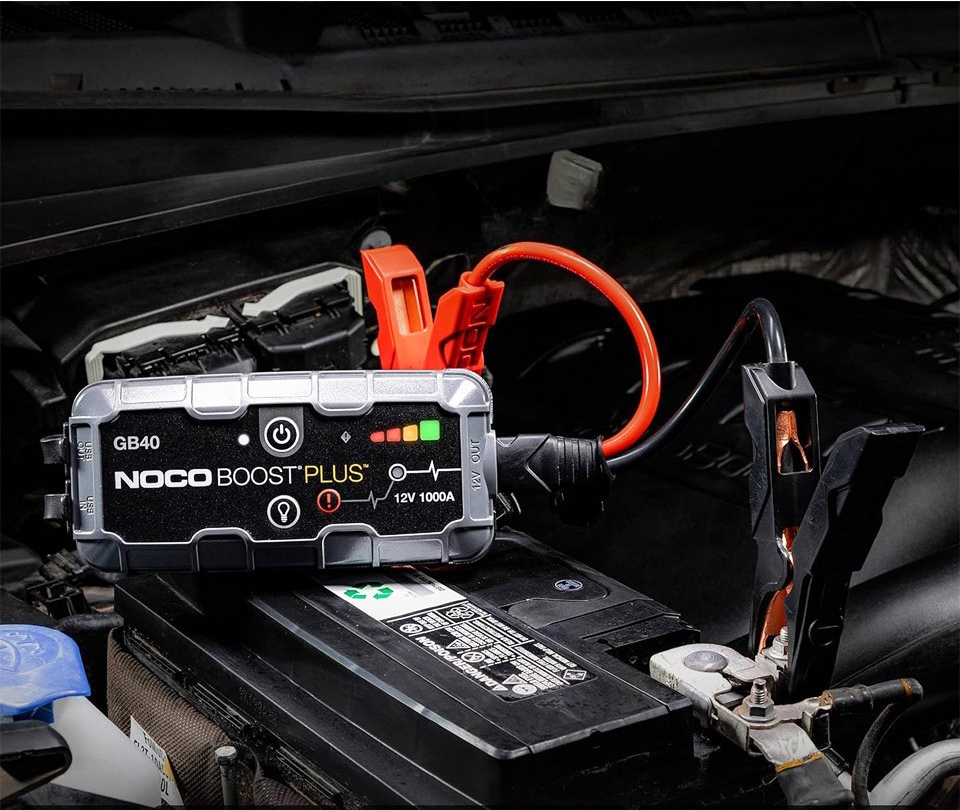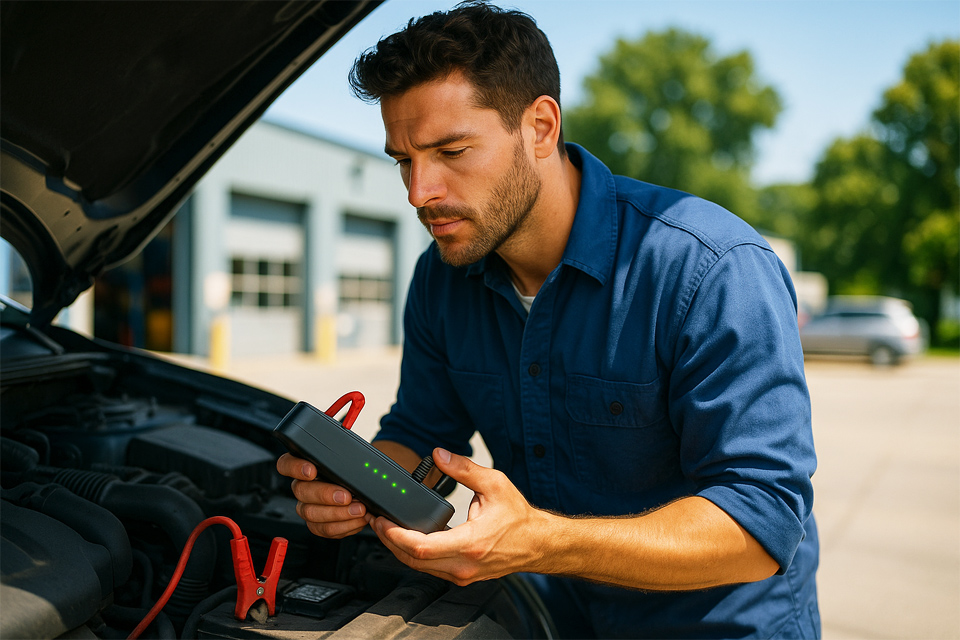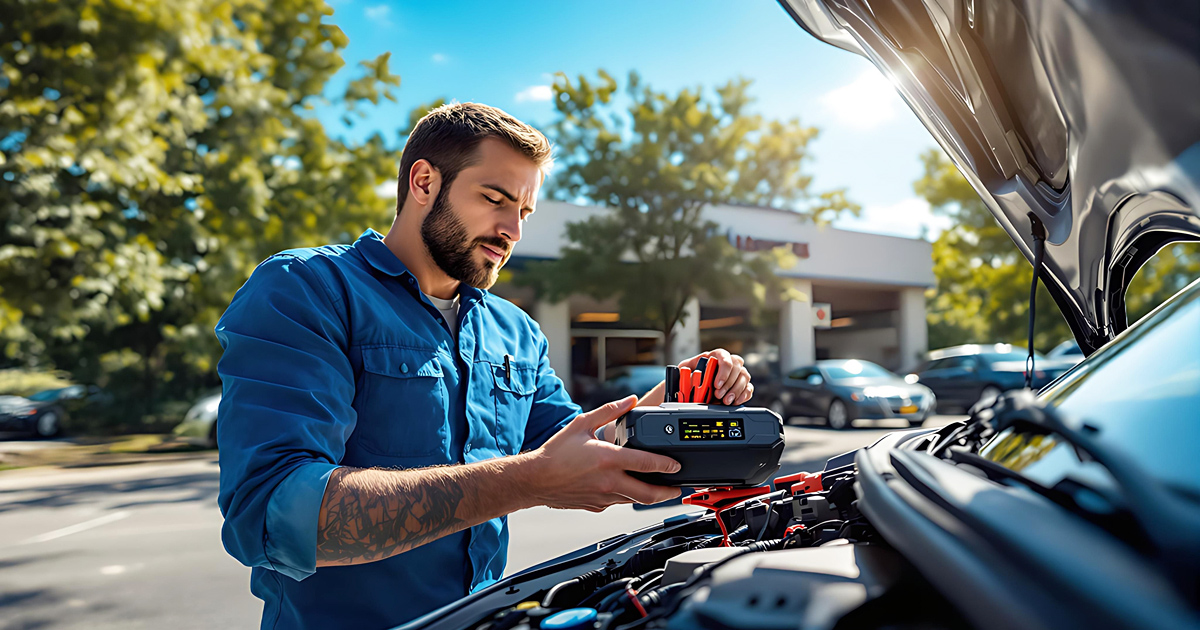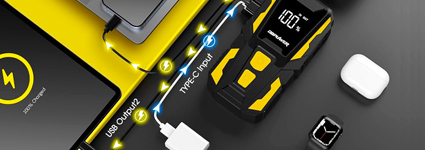We Use Car Jump Starters All The Time—But Do You Know These 5 Facts?
August 12th, 2025, Posted by travelwith2ofus

Car jump starters have become an essential tool for drivers everywhere, saving countless stranded motorists from dead batteries and long waits.
But beyond their everyday use, these handy devices have surprising stories and features that most people don’t know about.
From their early inventions to cutting-edge safety improvements, jump starters have evolved far beyond simple battery boosters.
If you think you know everything about them, think again. Here are five lesser-known facts about car jump starters that might change the way you see this vital piece of gear.
You may also be interested in this 4-way car battery jump starter comparison.
1. Jump Starters Can Help Protect Your Car’s Electronics
Modern portable jump starters often include built-in safety features designed to protect your vehicle’s sensitive electronics.
Unlike traditional jumper cables, which can cause voltage spikes and damage onboard computers or sensors, many compact jump starters use advanced circuitry to regulate power flow.
Features like reverse polarity protection, short-circuit prevention, and spark-proof technology reduce risks during use.
This makes jump starters safer for newer cars packed with electronic systems, providing peace of mind when you need a quick battery boost.
For example, brands like NOCO highlight these safety features prominently, reflecting the shift toward more tech-friendly jump-starting solutions.
2. Some Jump Starters Double as Power Banks for Your Devices
Beyond jump-starting your car, many modern jump starters serve as multi-functional power banks.
They often feature USB ports for charging smartphones, tablets, and other gadgets on the go.
This makes them a handy emergency tool for travelers, campers, or anyone needing portable power.
Instead of carrying separate chargers, a jump starter can keep both your car and your devices powered up, offering added convenience.
BOOK YOUR SANDALS VACATION
Get a free honeymoon package
Take your honeymoon to the next level at Sandals Resorts, where every moment is wrapped in luxury, romance, and breathtaking beauty made just for two… even though we know it’s about her


We (travelwith2ofus.com) have links to product and services from our affiliates. We may receive compensation when you click on those links, at no cost to you of course.
3. Many Modern Jump Starters Now Include Built-in Tire Compressors
The latest portable jump starters often come with an unexpected bonus: built-in tire compressors.
This combo device lets you not only jump-start your car’s battery but also inflate tires, bike tires, sports equipment, or inflatable gear on the go.
Having both functions in one compact, rechargeable unit is a huge convenience for travelers and drivers who want to be ready for roadside emergencies without carrying bulky equipment.
Brands like NOCO, Tacklife, and DBPOWER offer models with digital pressure gauges and automatic shutoff features, making it easy and safe to maintain proper tire pressure wherever you are.

4. Lithium-Ion Jump Starters Have Changed The Game
The shift from lead-acid batteries to lithium-ion technology has revolutionized jump starters. Lithium-ion jump starters are lighter, more compact, and hold a charge longer than traditional models.
They also deliver a powerful, consistent current that can start a wider range of engines, including larger trucks and SUVs.
Plus, lithium-ion models charge faster and are more durable, making them the preferred choice for most drivers today.
They Can Tell You Your Battery is Completely Dead (or Just Too Far Gone)
While traditional jumper cables are all about providing a dumb, brute-force jolt of electricity, many modern jump starters have a "smart" clamp system that can perform basic diagnostics.
Instead of simply trying to force a charge, these devices can read the voltage of your dead battery.
If the voltage is too low (e.g., below 2 volts), the device's screen might display an error code or an "override" prompt.
This serves as a vital safety check, preventing you from trying to jump a battery that is completely ruined or has a short circuit, which could be dangerous and damage your vehicle's electronics.
It tells you when a jump is a viable option versus when it's time for a replacement.
The history of car battery jump starters
The history of car battery jump starters is a story of a simple concept evolving from a manual, two-car process into a sophisticated, portable, and multi-functional device.
The evolution can be broken down into three main eras: the jumper cable era, the heavy lead-acid "jump box" era, and the modern lithium-ion era.
1. The Early Days: The Jumper Cable (Early 20th Century)
The concept of using one power source to revive another has existed for a long time, with some sources crediting an early form of jumper cables to an inventor named Leon Jumper in 1863 for use with other mechanical devices.
However, the use of jumper cables specifically for automobiles emerged in the early 20th century, as electric starters began to replace hand cranks.
The early method for jump-starting required two vehicles and a pair of long, thick, insulated wires with alligator clamps on each end.
This method was the industry standard for decades and came with well-known safety risks, such as the potential for sparks, electrical shorts, and reverse polarity.
This process was cumbersome and depended entirely on the availability of a second car.

2. The Heavy Lead-Acid "Jump Box" (1980s-1990s)
The first significant innovation was the introduction of the self-contained jump starter, often referred to as a "jump box" or "booster pack." These devices contained a large, internal lead-acid battery, similar to a car battery, in a protective plastic casing with attached cables.
- Technology: These were a major leap forward because they eliminated the need for a second vehicle. They allowed a driver to be self-sufficient in an emergency.
- Drawbacks: The main disadvantage was their size and weight. Due to the heavy lead-acid battery, these devices were often bulky and weighed 20-30 pounds, making them difficult to store and transport. They also had a reputation for losing their charge quickly if not maintained, and the lack of advanced safety features meant the risk of user error (like connecting the clamps incorrectly) was still high.
3. The Modern Era: Lithium-Ion Jump Starters (2010s-Present)
The most dramatic transformation came with the popularization of lithium-ion technology in the 2010s. As lithium-ion batteries became more powerful and cost-effective, they began to replace lead-acid batteries in jump starters.
- Size and Portability: Lithium-ion batteries have a much higher energy density than lead-acid, allowing manufacturers to create devices that are a fraction of the size and weight. This turned the jump starter from a bulky piece of equipment into a compact device that could easily fit in a glove compartment or under a seat.
- Smart Clamps and Safety: This era introduced "smart" or "intelligent" clamps. These clamps contain built-in microcontrollers that monitor the battery's voltage and polarity. They prevent power from flowing until a correct connection is detected, effectively eliminating the risk of sparks, over-current, and reverse-polarity hook-ups.
- Multi-Functionality: The compact power source and advanced electronics opened the door for new features. Modern jump starters often include multiple USB ports for charging phones and tablets, integrated LED flashlights, and even air compressors or 12V DC power outlets, transforming them into versatile emergency power banks.
Sources:
- Early Jumper Cables: Jumper cables for cars emerged in the early 20th century, coinciding with the rise of the electric starter. Learn more about the evolution of automotive technology at: Engineering.com
- Evolution of Battery Booster Packs: General resources on the evolution of automotive tools and battery technology provide context for the shift from heavy lead-acid to more portable units. Learn more at: Wikipedia
-
Lithium-Ion Technology: The widespread adoption of lithium-ion batteries transformed jump starters in the 2010s. Learn about the history of this technology at: Wikipedia
Book Your Travel:
▶ On Expedia
▶ On Travala (pay with Crypto)
Bible of Crypto Travel
Everything you need to know about exploring the world and paying with cryptocurrencies.
Check it out!

Check Out Our collections
Are you looking for a unique original gift friends and family members? I'm In Love With Me, I’m Not Skunk Like A Drunk!, and How Is My Driving designs.
Our designs are available on bumper stickers, coffee mugs, t-shirts, travel mugs and bottles, bath mats, sweatshirts, and hoodies.
▶︎ DEAL ALERT!
Book Your Travel To New Or Favorite Destinations.
Pay With Cryptos And SAVE UP TO 60%!
![]()
![]()
Book With Expedia: And Start Exploring
Our Latest Video: 10 European Street Foods You’ve Probably Never Heard Of (But Should Try)
You may also like:
GADGETS | GEAR | TRAVEL | MERCH
FASHION






 12 Romantic European Cities For A Blissful Couples’ Escape
12 Romantic European Cities For A Blissful Couples’ Escape New And Popular Amazon Gadget Releases At Prices You Can’t Ignore
New And Popular Amazon Gadget Releases At Prices You Can’t Ignore 10 Dreamy Romantic Caribbean Getaways Perfect For Couples
10 Dreamy Romantic Caribbean Getaways Perfect For Couples

 6 Original Graphic A-Line Dresses To Make Your Summer Sparkle
6 Original Graphic A-Line Dresses To Make Your Summer Sparkle